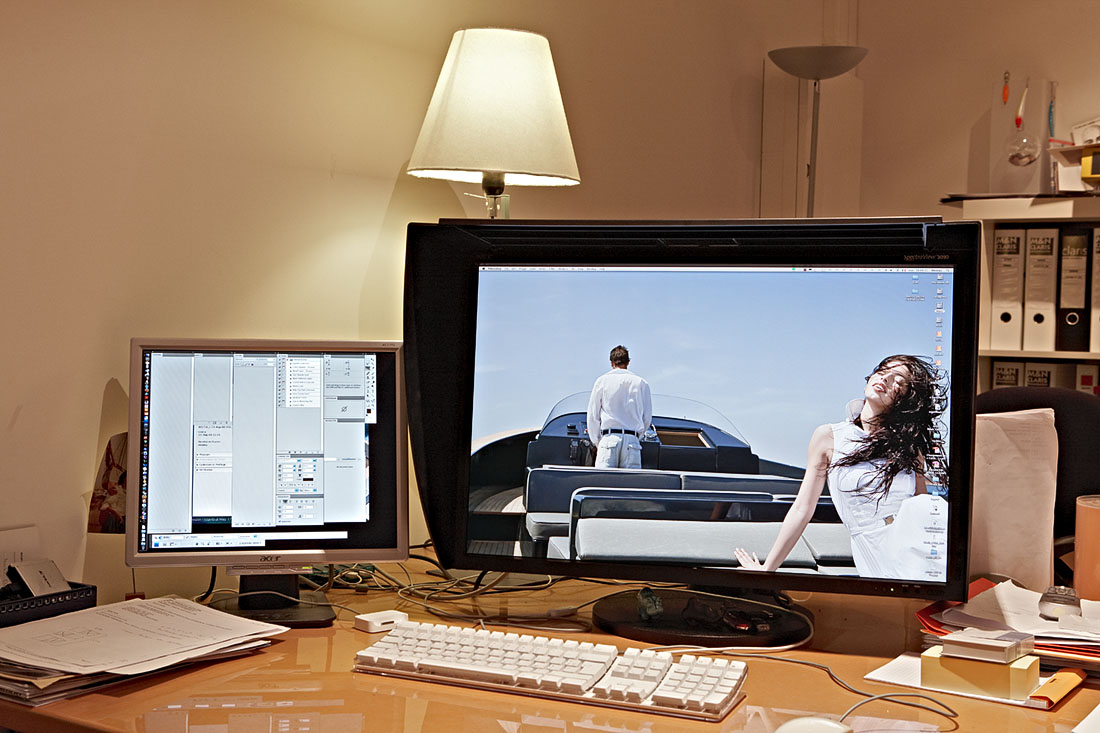nicolas claris
OPF Co-founder/Administrator
When I went to Photokina on the Sinar stand (the stand I came directly to at first entrance;-) I've been happy to see some people from Nec and basICColor doing demonstration of some Nec monitors and of course their flagship, the Spectraview 3090.
It was a good surprise as I had already stated here in OPF, that this monitor was on my wishlist…
So it was not difficult for Markus Hitzler to convince me, especially with Photokina special rates. That "thing" was to big for me to bring it back, but I received the box (more than 20 kilos!) a few days later as it had been promised…
Unpack was fast and easy (one can easily guess!).
After removing the 3 years old Nec 2180UX, I just plugged the new monitor and this was it!
The cover all around brings a very good protecton from lights around and I've never been ennoyed by reflections or any glares…
I already had an i1Display 2 so profiling the monitor with the Spectraview software profiler was very simple and … accurate!
My settings:
Hardware calibration: Pre-press
Whit Point D50
Tonal curve: L*
Liminance: white 130 cd/m2 - Black neutral minimal
Profiling: LUT - 16 bits, v4
The monitor is plugged to the NVIDIA GeForce 8800 GT of my MacPro together with the second "ordinary" monitor (for palettes and emails window.)
The 3090 displays 2560 x 1600 pixels. What you see on the snap below is my new set-up. The image displayed by the Spectraview is a little less than 50% of a 1Ds3 file…
The only little downside of this monitor is, at it displays the Adobe RGB color space, you will see images and thumbnails quite "bizzare" within any software not color managed… but as pro we all use only color managed software, so who cares!
Later I'll post my findings with the camera calibrator (basICColor "input" creates ICC profi les for scanners and digital cameras) I bought in the same time…

Image edited on my MacBookPro not color managed…
It was a good surprise as I had already stated here in OPF, that this monitor was on my wishlist…
So it was not difficult for Markus Hitzler to convince me, especially with Photokina special rates. That "thing" was to big for me to bring it back, but I received the box (more than 20 kilos!) a few days later as it had been promised…
Unpack was fast and easy (one can easily guess!).
After removing the 3 years old Nec 2180UX, I just plugged the new monitor and this was it!
The cover all around brings a very good protecton from lights around and I've never been ennoyed by reflections or any glares…
I already had an i1Display 2 so profiling the monitor with the Spectraview software profiler was very simple and … accurate!
My settings:
Hardware calibration: Pre-press
Whit Point D50
Tonal curve: L*
Liminance: white 130 cd/m2 - Black neutral minimal
Profiling: LUT - 16 bits, v4
The monitor is plugged to the NVIDIA GeForce 8800 GT of my MacPro together with the second "ordinary" monitor (for palettes and emails window.)
The 3090 displays 2560 x 1600 pixels. What you see on the snap below is my new set-up. The image displayed by the Spectraview is a little less than 50% of a 1Ds3 file…
The only little downside of this monitor is, at it displays the Adobe RGB color space, you will see images and thumbnails quite "bizzare" within any software not color managed… but as pro we all use only color managed software, so who cares!
Later I'll post my findings with the camera calibrator (basICColor "input" creates ICC profi les for scanners and digital cameras) I bought in the same time…

Image edited on my MacBookPro not color managed…
